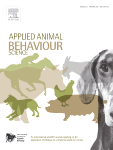Document type: scientific article published in Applied Animal Behaviour Science
Authors: Uri Baqueiro-Espinosa, Paul Donnelly, Victoria McEvoy, Gareth Arnott
Preview: In dogs, maternal behaviour plays an essential role in offspring survival and can influence the development and behaviour of the neonate later in life. We investigated the effect of prepartum enrichment on maternal behaviour and welfare of breeding dams at a large-scale commercial dog breeding establishment. During the last four weeks of gestation, dams were exposed to either baseline management conditions (control N = 13) or an additional enrichment protocol based on positive human interaction (enriched N = 13). We then recorded the duration of mother-puppy interactions throughout the first three weeks postpartum. Hair samples for cortisol analysis were collected at four timepoints: 3rd week of gestation, last week of gestation, 4th week postpartum, and 8th week postpartum. Additionally, the behaviour of the dams was assessed during the 3rd week of gestation. We hypothesised that, compared to control dams, enriched mothers would show higher levels of maternal behaviour and lower post-treatment and post-partum levels of hair cortisol. With the exception of vertical nursing, all the recorded maternal behaviour variables declined over time. None of the maternal behaviour variables were significantly affected by the enrichment treatment. However, as litter size increased, enriched dams spent marginally more time nursing their puppies in a sitting or standing posture (vertical nursing). Similarly, as litter size increased, enriched dams had significantly lower average hair cortisol concentration (HCC) levels compared to dams in the control group. Furthermore, dams scoring higher in the pre-treatment behavioural assessment (being more social towards humans and other dogs, less fearful and reactive, and more willing to play and interact with unfamiliar stimuli) had lower HCC levels. HCC did not vary significantly across the four timepoints. Overall, these findings suggest that although higher HCC levels in dams bearing larger litters could be associated with elevated energy mobilisation during pregnancy and lactation, a potential stress-mitigating effect of the positive human interaction cannot be excluded. Further studies should investigate this potential stress-mitigating effect using additional welfare indicators.






